Table of Contents
Overview – Antibodies
Antibodies are specialised immunoglobulin proteins produced by plasma cells in response to antigen exposure. They play a central role in the adaptive immune system, with diverse effector functions including pathogen neutralisation, opsonisation, complement activation, and antibody-dependent cellular cytotoxicity. Understanding antibody structure, function, and isotype diversity is essential for grasping immune defence, vaccine mechanisms, and immunotherapy.
Definition
- Antibodies = Immunoglobulin (Ig) proteins that bind specifically to antigens
- Produced by plasma cells (differentiated B cells) after infection or immunisation
- Found:
- Freely in plasma
- As B cell receptors (BCRs) on B lymphocytes
Functions of Antibodies
- Neutralisation
- Bind directly to viruses, bacteria, or toxins → prevent cellular entry or toxicity
- Neutralised particles are then phagocytosed


- Opsonisation
- Antibodies coat pathogens → enhance recognition by phagocytes via Fc receptors
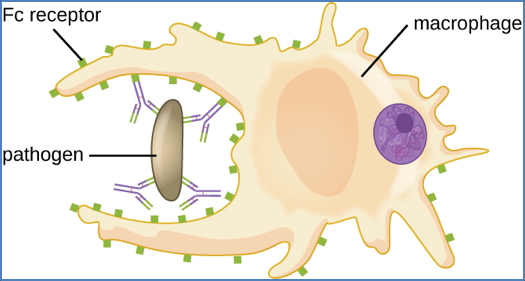

- Complement Activation
- Trigger classical complement pathway → lysis of extracellular microbes
- Agglutination
- Cross-link multiple pathogens → form antigen-antibody complexes
- Facilitates clearance by phagocytes
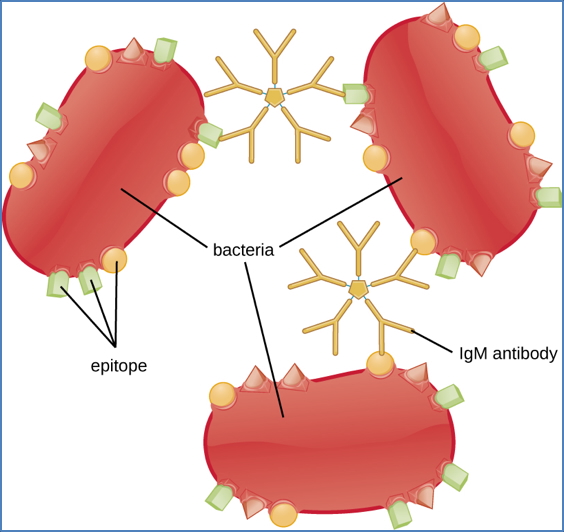

- Antibody-Dependent Cellular Cytotoxicity (ADCC)
- Antibodies bind infected or abnormal cells → recruit:
- Natural killer (NK) cells → cell lysis
- Eosinophils (via IgE) → parasite destruction
- Antibodies bind infected or abnormal cells → recruit:


Antibody Structure
- Y-shaped molecule with:
- 2x Heavy chains (long)
- 2x Light chains (short)
- Each chain has:
- Constant region (Fc) → interacts with immune effectors
- Variable region (Fab) → binds specific antigen
Functional Regions
- Fab (Fragment Antigen-Binding):
- Contains VH (variable heavy) & VL (variable light)
- Recognises epitopes on antigen
- Includes complementarity-determining regions (CDRs)
- Fc (Fragment Crystallisable):
- Constant region of heavy chain
- Binds Fc receptors on phagocytes, NK cells, mast cells
- Activates complement pathway
- Hinge Region:
- Formed by heavy chains
- Provides flexibility → enables cross-linking
- Stabilised by disulphide bonds


Antibody Diversity Generation
Primary Diversification – During B cell maturation
- Ig Gene Rearrangement:
- Heavy chains: V, D, J gene recombination
- Light chains: V, J gene recombination
- Generates a wide repertoire of BCR/antibody variants
- Mirrors T cell receptor (TCR) rearrangement in T cells
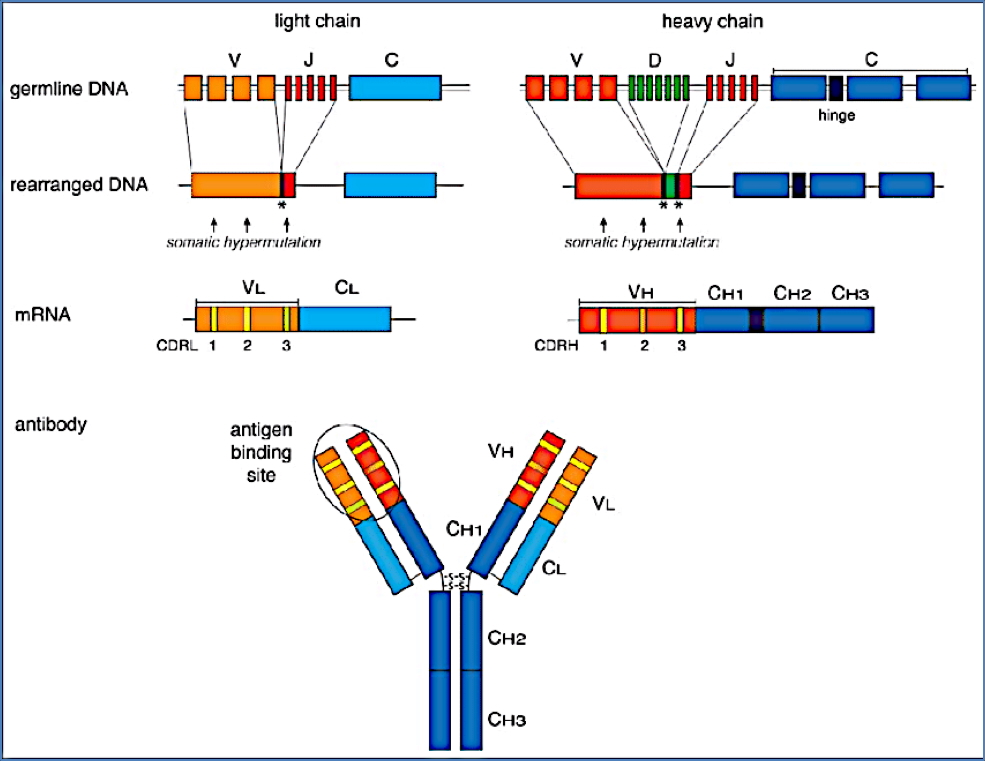

Secondary Diversification – In activated B cells
- Somatic Hypermutation (in germinal centres):
- Point mutations in variable region genes
- Results in altered affinity for antigen
- High-affinity clones are selected for clonal expansion
- Isotype Switching:
- Fc region genes replaced → switch from IgM to IgG, IgA or IgE
- Requires CD4+ helper T cell interaction (via CD40/CD40L)
- Cytokine-dependent (dictates isotype produced)
- Antigen specificity is retained; only effector function changes
Isotype Switching
- Naive B cells express IgM and IgD
- First antibody secreted = IgM
- Later, plasma cells switch to:
- IgG1/2/3/4
- IgA
- IgE
- Switch requires:
- CD4+ helper T cell cytokines
- CD40-CD40L interaction
- Antigen type (thymus-dependent vs thymus-independent)
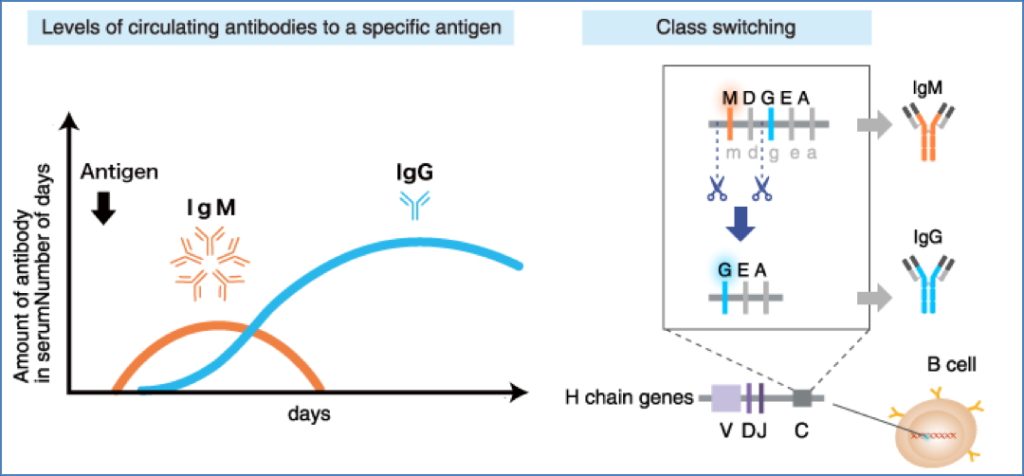

Antibody Isotypes
| Isotype | Functions | Structure |
|---|---|---|
| IgM | First responder; neutralisation, opsonisation, complement activation; BCR | Pentamer (in serum), Monomer (on B cells) |
| IgD | BCR on naive B cells | Monomer |
| IgG | Major serum antibody; neutralisation, opsonisation, complement activation, placental transfer | Monomer |
| IgA | Mucosal immunity (secretions, breast milk, GIT, respiratory tract) | Dimer (in secretions), Monomer (in serum) |
| IgE | Allergic responses, parasite defence; binds mast cells → histamine/serotonin release | Monomer |
Note: IgM and IgE have an additional constant domain (CH3) compared to other isotypes.


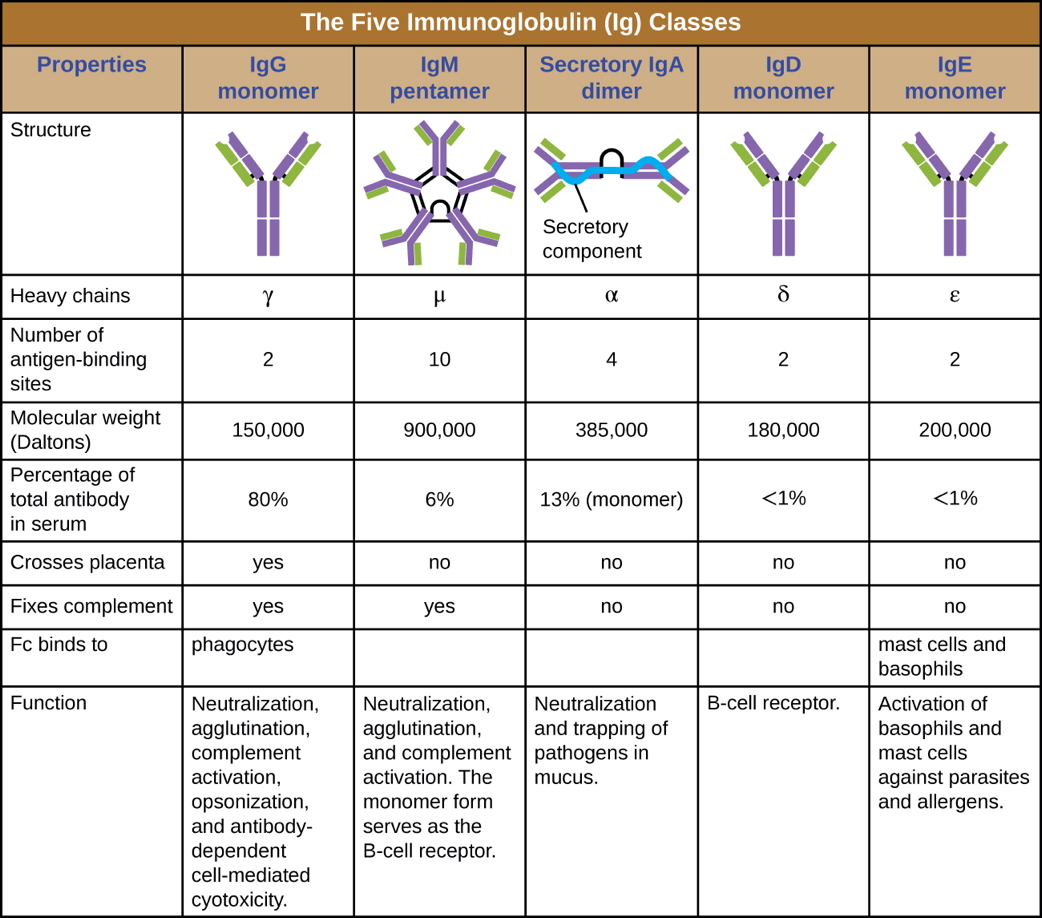

Summary – Antibodies
Antibodies are key effectors of the adaptive immune system, functioning through antigen binding, opsonisation, neutralisation, complement activation, and isotype-specific immune responses. Structural variation and diversification mechanisms equip them to combat a wide range of pathogens. For a broader context, see our Immune & Rheumatology Overview page.